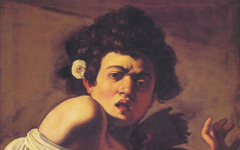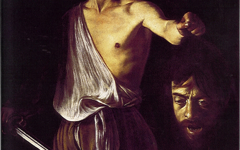Caravaggio’s Narcissus (c.1597-9)
Many Caravaggio specialists have recognized that the figures in Caravaggio’s earliest paintings contain variations on his own facial features, what we call face fusion, and some have noted that they are “narcissistic”1. In this slightly later image, the actual figure of Narcissus, who was thought in the fifteenth century to be the legendary inventor of painting, looks down at his own reflection in the water. It is a concise expression of the idea that “every painter paints himself.”

Caravaggio, Narcissus (c.1597-9) Oil on canvas. Galleria Nazionale d'Arte Antica
Click image to enlarge.
The composition forms a circle with the well-lit knee above the center of the dividing line. This makes the upper semi-circle resemble an eye with a bright pupil. If so, the arms around it represent the manual craft of visual art. On the narrative level, the river Styx reflects Narcissus’ image in perpetuity, as Ovid wrote. However, on the inner level, as an expert correctly noted, Narcissus’ self-love can be understood as man’s love of God and the desire to be at one with Christ.2 Devotees of such practice searched inwards to purify their own souls by making the opposites of the mind's dualities unite. The full circle of Narcissus and his reflection - the semi-circle of an "outer eye" above and its shadowy "inner eye" below - represents Caravaggio's own imagination, outer brightness joined to inner darkness, insight with exterior vision.
The pose was imitated by a number of later artists including Orazio Gentilleschi, Domenichino and Poussin.3 Artemisia Gentilelleschi, Orazio’s daughter, turned the pose 90 degrees to the left when she painted her own self-portrait. With its clear reference to Caravaggio’s Narcissus, an artist she greatly admired, Artemisia also implies, at least to subsequent artists who could read her visual language, that “every painter paints himself” and that the surface of the painting, like the surface of the water, reflects the artist. The use of her own self-portrait in the painting confirms her interpretation of Caravaggio’s.
More Works by Caravaggio
Learn how a common pose in art carries specific meaning, regardless of subject matter

Over-the-Shoulder Poses
Notes:
1. Helen Langdon, “Caravaggio: Biography in Paint” in Caravaggio and Paintings of Realism in Malta (Valetta: St. John’s Co-Cathedral) 2007, pp. 55
2. Posèq, “The Allegorical Content of Caravaggio’s Narcissus”, Source 10, Spring 1991, pp. 26 and note 14, p. 28
3. Catherine Puglisi, Caravaggio (London: Phaidon) 1998, p.106
Original Publication Date on EPPH: 13 Jun 2010. | Updated: 0. © Simon Abrahams. Articles on this site are the copyright of Simon Abrahams. To use copyrighted material in print or other media for purposes beyond 'fair use', you must obtain permission from the copyright owner. Websites may link to this page without permission (please do) but may not reproduce the material on their own site without crediting Simon Abrahams and EPPH.



